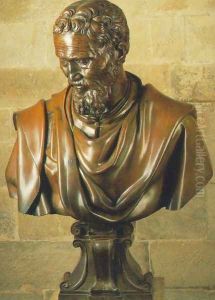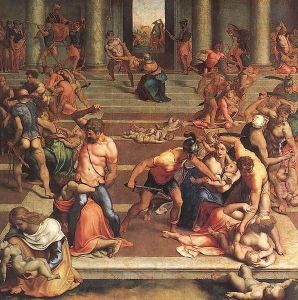Daniele Ricciarelli Paintings
Daniele Ricciarelli, better known as Daniele da Volterra, was an Italian Mannerist painter and sculptor of the Renaissance period. Born in 1509 in Volterra, Tuscany, he is most famous for his association with Michelangelo and for partially overpainting the nude figures in the Sistine Chapel, earning him the nickname 'Il Braghettone' ('the breeches maker').
Daniele da Volterra's early training is not well documented, but it is believed that he may have been a pupil of Sodoma or Peruzzi in Siena before moving to Rome. His style was significantly influenced by Michelangelo, and his work exhibits the robust, muscular forms and the complex composition that are typical of the High Renaissance and Mannerist aesthetic. One of his most notable works is 'The Descent from the Cross' (circa 1545–1553), located in the Trinità dei Monti in Rome, which exemplifies his mastery of human anatomy and his ability to create dramatic and emotional narratives.
Da Volterra enjoyed the patronage of prominent figures of his time, including the Medici family. His relationship with Michelangelo was both professional and personal; not only did he paint and sculpt in a manner reminiscent of Michelangelo, but he also became a close friend and, in Michelangelo's later years, one of his few trusted companions.
After Michelangelo’s death in 1564, Daniele da Volterra was tasked with the controversial job of painting draperies over some of the nude figures in the Last Judgment in the Sistine Chapel, an act in accordance with the Counter-Reformation's call for modesty and decorum in religious art. This action has marred his reputation to some extent, though it was done under papal order.
Daniele da Volterra's career faced challenges towards the end of his life as Mannerism fell out of favor and the new Baroque style began to take precedence. Despite this, he remained an important figure for his connections to the older generation of Renaissance artists and as a bridge to the new artistic trends emerging in the late 16th century. Daniele da Volterra died in 1566 in Rome, leaving behind a body of work that, while overshadowed by his more famous contemporaries, provides valuable insight into the transitional period of Mannerism in Italian art history.

